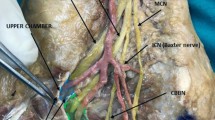Abstract
Purpose
The purpose of our study is to present the anatomical bases of a new technique for endoscopic tarsal release and to report the preliminary clinical outcome for this technique.
Method
Anatomical study The technique was performed on 12 intact adult lower limb specimens. The location of portals was evaluated as well as the integrity of the neurovascular bundle. Ultra-sonographic study A prospective case control study was done on 10 patients (11 feet) and 14 normal volunteers (28 feet). Three parameters were measured; the thickness of flexor retinaculum, the nerve cross-section area and the depth of tarsal tunnel. Clinical study Seven patients with idiopathic proximal Tarsal Tunnel Syndrome (TTS) were treated by endoscopic TTR using a modified trocar cannula and dilator system. Preoperative and postoperative evaluation was done by electrophysiological studies and ultra-sonography. Evaluation was done using Takakura’s rating scale.
Results
Anatomical study The proximal and distal portals were located at 13 mm (±1.59 STD) and 17.91 mm (±1.44 STD) from the proximal and distal borders of FR, respectively. There was intact neurovascular bundle in all specimens. Ultra-sonographic study There was statistically significant difference in the mean nerve cross-sectional area and the thickness of the FR between the control group and the patients group (P < 0.05). Clinical study The mean TRS improved from 2.28 ± 1.11 STD preoperatively to 8.43 ± 0.97 at 2 years follow-up. The overall good to excellent results was 85.7%.
Conclusion
Based on this preliminary clinical study, endoscopic tarsal tunnel release by the technique described could obtain excellent to good results in 85.7% of patients with idiopathic proximal tarsal tunnel. The anatomical study proved the safety of the technique on the neurovascular structures. Ultra-sonography was an effective tool for preoperative diagnosis and postoperative follow-up.
Level of evidence Case series study, Level IV.




Similar content being viewed by others
References
Aktan Ikiz ZA, Ucerler H, Uygur M (2007) Dimensions of the anterior tarsal tunnel and features of the deep peroneal nerve in relation to clinical application. Surg Radiol Anat 29(7):527–530
Alshami AM, Cairns CW, Wylie BK, Souvlis T (2009) Reliability and size of the measurement error when determining the cross-sectional area of the tibial nerve at the tarsal tunnel with ultrasonography. Ultrasound Med Biol 35(7):1098–1102. doi:10.1016/j.ultrasmedbio.2009.01.011
Andreasen LN, Birn H, Teglbjaerg PS, Haase J, Struijk JJ (2010) Size and separability of the calcaneal and the medial and lateral plantar nerves in the distal tibial nerve. Anat Sci Int 85(1):13–22. doi:10.1007/s12565-009-0045-y
Baba H, Wada M, Annen S, Azuchi M, Imura S, Tomita K (1997) The tarsal tunnel syndrome: evaluation of surgical results using multivariate analysis. Int Orthop 21(2):67–71. doi:10.1007/s002640050122
Bain GI, Bajhau A (2005) Endoscopic release of the ulnar nerve at the elbow using the Agee device: a cadaveric study. Arthroscopy 21(6):691–695. doi:10.1016/j.arthro.2005.02.018
Cain JD, DiNucci K (2009) Revisional peripheral nerve surgery. Clin Podiatr Med Surg 26(1):11–22. doi:10.1016/j.cpm.2008.10.002
Cimino WR (1990) Foot Ankle 11(1):47–52
Day FN, Naples J (1996) endoscopic tarsal tunnel release: update 96. J Foot Ankle Surg 35(3):225–229
Gondring WH, Trepman E, Sheilds B (2009) Tarsal tunnel syndrome: assessment of treatment outcome with an anatomic pain intensity scale. Foot Ankle Surg 15:133–138. doi:10.1016/j.fas.2008.10.003
Heimkes B, Posel P, Stotz S, Wolf K (1987) The proximal and distal tarsal tunnel syndromes: an anatomical study. Int Orthop 11:193–196. doi:10.1007/BF00271447
Jerosch J, Schunck J, Khoja A (2006) Results of surgical treatment of tarsal tunnel syndrome. Foot Ankle Surg 12:205–208. doi:10.1016/j.fas.2006.05.001
Keck C (1962) The tarsal tunnel syndrome. J Bone Joint Surg 44-A:180
Lam SJS (1962) A tarsal tunnel syndrome. Lancet 2:1354
Lau JT, Stavrou P (2004) Posterior tibial nerve—primary. Foot Ankle Clin 9:271–285. doi:10.1016/j.fcl.2003.12.002
Mondelli M, Cioni R (1998) Electrophysiological evidence of a relationship between idiopathic carpal and tarsal tunnel syndromes. Neurophysiol Clin 28:391–397. doi:10.1016/S0987-7053(99)80023-9
Mondelli M, Giannini F, Reale F (1998) Electroencephalogr Clin Neurophysiol 109:418–425. doi:10.1016/S0924-980X(98)00039-3
Okan B, Mehmet A, Figen G (2003) Neurovascular branching in the tarsal tunnel. Neuroanatomy 2:39–41
Preston DC, Shapiro BE (2005) Nerve conduction studies: normal adults values. In: Preston DC, Shapiro BE (eds) Electromyography and neuromuscular disorders. Clinical electropysiologic correlations, 2nd edn. Elsevier, Butterworth, pp 663–665
Sora MC, Jilavu R, Grübl A, Genser-Strobl B, Staykov D, Seicean A (2008) The posteromedial neurovascular bundle of the ankle: an anatomic study using plastinated cross sections. Arthroscopy 24(3):258–263. doi:10.1016/j.arthro.2007.08.030
Takakura Y, Kitada C, Sugimoto K, Tanaka Y, Tamai S (1991) Tarsal tunnel syndrome. Causes and results of operative treatment. J Bone Joint Surg Br 73:125–128
Ürgüden M, Bilbas H, Özdemir H, Söyüncü Y, Gür S, Aydin AT (2002) Tarsal tunnel syndrome–the effect of the associated features on outcome of surgery. Int Orthop 26:253–256. doi:10.1007/s00264-002-0351-7
Vasiliadis HS, Xenakis TA, Mitsionis G, Paschos N, Georgoulis A (2010) Endoscopic versus open carpal tunnel release. Arthroscopy 26(1):26–33. doi:10.1016/j.arthro.2009.06.027
Williams T, Robinson A (2009) Entrapment neuropathies of the foot and ankle. Orthoped Trauma 23(6):404–411. doi:10.1016/j.mporth.2009.09.004
Conflict of interest
The authors declare that they have no conflict of interest.
Author information
Authors and Affiliations
Corresponding author
Rights and permissions
About this article
Cite this article
El Shazly, O., El Shazly, A., Desouky, A. et al. Anatomical bases of endoscopic tarsal tunnel release: anatomical and ultra-sonographic study with a preliminary clinical report. Surg Radiol Anat 33, 929–936 (2011). https://doi.org/10.1007/s00276-011-0890-y
Received:
Accepted:
Published:
Issue Date:
DOI: https://doi.org/10.1007/s00276-011-0890-y




